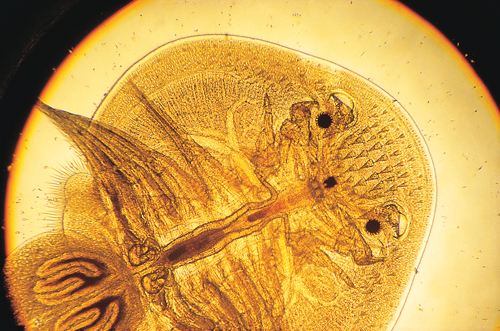Difference between revisions of "Ornamental Fish Q&A 10"
Jump to navigation
Jump to search
(Created page with "[[|centre|500px]] <br /> <br /> <FlashCard questions="4"> |q1=What is the common name of this parasite (×20)? |a1= The fish louse. |l1= |q2=What is its genus? |a2= ''Argulus...") |
|||
| (3 intermediate revisions by 3 users not shown) | |||
| Line 1: | Line 1: | ||
| − | [[|centre|500px]] | + | {{Manson |
| + | |book = Ornamental Fish Q&A}} | ||
| + | |||
| + | [[File:Ornamental Fish 10.jpg|centre|500px]] | ||
<br /> | <br /> | ||
| Line 10: | Line 13: | ||
|a1= | |a1= | ||
The fish louse. | The fish louse. | ||
| − | |l1= | + | |l1= Fish Louse |
|q2=What is its genus? | |q2=What is its genus? | ||
|a2= | |a2= | ||
| − | ''Argulus''. | + | ''Argulus sp.''. |
| − | |l2= | + | |l2= Fish Louse#Introduction |
|q3=How does it feed? | |q3=How does it feed? | ||
|a3= | |a3= | ||
This parasite feeds by piercing the skin with its sharp stylet (visible along the ventral midline of the animal) and then sucking up body fluids with its mouth parts. | This parasite feeds by piercing the skin with its sharp stylet (visible along the ventral midline of the animal) and then sucking up body fluids with its mouth parts. | ||
| − | |l3= | + | |l3= Fish Louse#Pathology and Clinical Signs |
|q4=What are the major clinical concerns with this parasite? | |q4=What are the major clinical concerns with this parasite? | ||
|a4= | |a4= | ||
Although a light ''Argulus'' infection is rarely fatal, the parasites irritate the skin, making the fish stressed and uncomfortable. | Although a light ''Argulus'' infection is rarely fatal, the parasites irritate the skin, making the fish stressed and uncomfortable. | ||
| − | A heavy fish louse infestation may allow opportunistic pathogens to infect the host, and fish lice are known directly to transmit | + | A heavy fish louse infestation may allow opportunistic pathogens to infect the host, and fish lice are known directly to transmit bacterial and viral diseases. |
| − | bacterial and viral diseases. | + | |l4= Fish Louse#Pathology and Clinical Signs |
| − | |l4= | ||
</FlashCard> | </FlashCard> | ||
Latest revision as of 13:39, 22 November 2011
| This question was provided by Manson Publishing as part of the OVAL Project. See more Ornamental Fish Q&A. |
| Question | Answer | Article | |
| What is the common name of this parasite (×20)? | The fish louse. |
Link to Article | |
| What is its genus? | Argulus sp.. |
Link to Article | |
| How does it feed? | This parasite feeds by piercing the skin with its sharp stylet (visible along the ventral midline of the animal) and then sucking up body fluids with its mouth parts. |
Link to Article | |
| What are the major clinical concerns with this parasite? | Although a light Argulus infection is rarely fatal, the parasites irritate the skin, making the fish stressed and uncomfortable. A heavy fish louse infestation may allow opportunistic pathogens to infect the host, and fish lice are known directly to transmit bacterial and viral diseases. |
Link to Article | |
